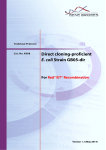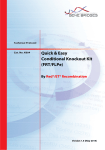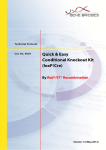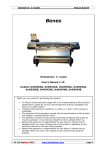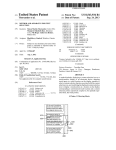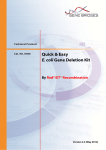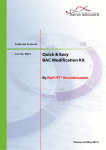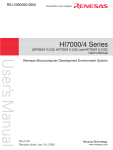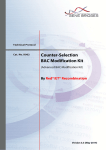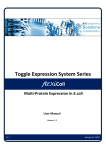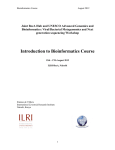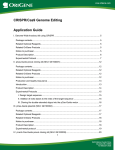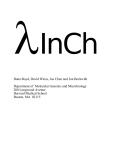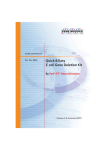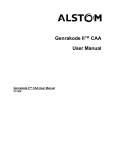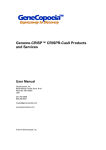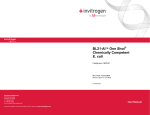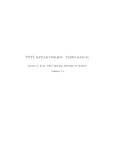Download Recombineering-proficient E. coli Strain GB08-red
Transcript
Technical Protocol Cat. No. K009 Recombineering-proficient E. coli Strain GB08-red For Red®/ET® Recombination Version 1.1 (May 2014) CONTENTS 1 Recombineering-proficient E. coli Strain GB08-red .................................................................. 2 2 Experimental Outline .................................................................................................................... 3 3 How Red/ET Recombination works ............................................................................................ 4 4 Technical protocol ........................................................................................................................ 5 4.1 Generation of a functional cassette flanked by homology arms ............................................ 5 4.2 Insertion of a PGK-gb2-neo cassette into a plasmid backbone ............................................. 6 4.3 Verification of successfully modified plasmid by restriction analysis ..................................... 8 4.4 Maps and sequences ............................................................................................................. 9 5 Troubleshooting.......................................................................................................................... 10 6 References and Patents ............................................................................................................. 12 6.1 References ........................................................................................................................... 13 6.2 Patents ................................................................................................................................. 13 7 Purchaser Notification/Warranty ............................................................................................... 13 8 Other products available from Gene Bridges .......................................................................... 14 9 DNA Engineering Services Available from Gene Bridges ...................................................... 15 Please read The products listed in this manual are for research purposes only. They are not designed for diagnostic or therapeutic use in humans, animals or plants. Success depends on following the protocols exactly as they are described. Do read the trouble-shooting guide before beginning your experiments. Red/ET Recombination is the intellectual property of Gene Bridges GmbH. Safety Some chemical reagents used with this system are dangerous if handled carelessly. Take care when using chemical reagents (such as isopropanol and ethidium bromide) and electrical apparatus (high-voltage power supplies, gel electrophoresis and electroporation apparatus). Follow the manufacturer’s safety recommendations. 2 Gene Bridges – Recombineering-proficient E. coli Strain GB08-red, Version 1.1 (May 2014) 1 Recombineering-proficient E. coli Strain GB08-red Introduction Red/ET recombination relies on homologous recombination in vivo in E.coli and allows a wide range of modifications on DNA molecules of any size and at any chosen position. Homologous recombination is the exchange of genetic material between two DNA molecules in a precise, specific and accurate manner. Homologous recombination occurs through homology regions, which are stretches of DNA shared by the two molecules that recombine. Because the sequence of the homology regions can be chosen freely, any position on a target molecule can be specifically altered. Red/ET recombination allows you to choose homology arms as short as 50 bp for homologous recombination, which can easily be added to a functional cassette by long PCR primers. E. coli strain GB08-red harbours an arabinose inducible gbaA operon (redγ, redβ, redα and recA) at the ybcC locus (Fu et al. 2010). The “PGK-gb2-neo” cassette supplied with the kit is designed to allow kanamycin/neomycin selection in prokaryotic and eukaryotic cells, respectively. It combines a prokaryotic promoter (“gb2”) for expression of kanamycin resistance in E.coli with a eukaryotic promoter (“PGK”) for expression of neomycin resistance in mammalian cells. The prokaryotic promoter gb2 is a slightly modified version of the Em7 promoter; it mediates higher transcription efficiency than the generally used Tn5 promoter. The promoter of the mouse phosphoglycerate kinase gene (PGK) is used as the eukaryotic promoter. A synthetic polyadenylation signal terminates kanamycin/neomycin expression. Contents of the kit: 1. GB08-red: Glycerol stock of recombineering-proficient E. coli strain GB08-red (500 µl, 25% glycerol) 2. PGK-gb2-neo PCR-product: PGK-gb2-neo cassette flanked by 50 bp long homology arms for the control experiment (100 ng/µl, 10 µl) 3. pSub-Hoxa11: high copy plasmid containing 15 kb of the mouse Hoxa11 gene for the control experiment (100 ng/µl, 20 µl) 4. This manual with protocols, maps and sequences Please store tube 1 at -80°C, tubes 2 - 3 at -20°C. Gene Bridges – Recombineering-proficient E. coli Strain GB08-red, Version 1.1 (May 2014) 3 2 Experimental Outline Figure 1: workflow. 1. Transform E. coli GB08-red cells with a mixture of linear DNA and circular plasmid. For your convenience a plasmid and a control insert (kanamycin resistance marker gene) sharing 50bp of terminal homology arms are provided for a control experiment. 2. Red/ET Recombination step. The expression of redα and redβ genes mediating Red/ET recombination is induced by the addition of L-arabinose. After induction, the cells are prepared for electroporation. Subsequently the circular plasmid and the linear fragment (PCR product) are co-electroporated. Since the PCR product encodes for a kanamycin resistance gene only colonies carrying successfully modified plasmids will survive kanamycin selection on the agar plates. Subsequent DNA mini preparation is used to confirm the successful integration of the DNA fragment. In most cases an additional retransformation step is required to isolate the modified plasmid from all copies of the original plasmid. 4 Gene Bridges – Recombineering-proficient E. coli Strain GB08-red, Version 1.1 (May 2014) 3 How Red/ET Recombination works Target DNA molecules are precisely altered by homologous recombination in E. coli cells which express the phage-derived protein pairs, either RecE/RecT from the Rac prophage, or Redα/Redβ from phage. These protein pairs are functionally and operationally similar. RecE and Redα are 5‘- 3‘ exonucleases, and RecT and Redβ are DNA annealing proteins. A functional interaction between RecE and RecT, or between Redα and Redβ is also required in order to catalyse the homologous recombination reaction. Recombination occurs through homology regions, which are stretches of DNA shared by the two molecules that recombine (Figure 2). The recombination is further assisted by -encoded Gam protein, which inhibits the RecBCD exonuclease activity of E.coli. Figure 2: Mechanism of Red/ET Recombination. Gene Bridges – Recombineering-proficient E. coli Strain GB08-red, Version 1.1 (May 2014) 5 Double-stranded break repair (DSBR) is initiated by the recombinase protein pairs, RecE/RecT or Red/Red First RecE (or Red) digests one strand of the DNA from the double-stranded break, leaving the other strand as a 3’ ended, single-stranded DNA overhang. Then RecT (or Red) binds and coats the single strand. The protein-nucleic acid filament aligns with homologous DNA. Once aligned, the 3’ end becomes a primer for DNA replication. E. coli strain GB08-red harbours an arabinose inducible gbaA operon (redγ, redβ, redα and recA) at the ybcC locus (Fu et al. 2010). The recombination window is therefore limited by the transient expression of the recombineering proteins. Thus, the risk of unwanted intra-molecular rearrangement is minimized. 4 Technical protocol 4.1 Generation of a functional cassette flanked by homology arms Oligonucleotide design I) Choose 50 nucleotides (N)50 directly adjacent upstream (5’) to the intended insertion site. Order an oligonucleotide with this sequence at the 5’ end. At the 3’ end of this oligo include the PCR primer sequence for amplification of the PGK-gb2-neo cassette, given in italics below. Upper oligonucleotide (oligo 1): 5’-(N)50 *AATTAACCCTCACTAAAGGGCG -3’ II) Choose 50 nucleotides (N)50 directly adjacent downstream (3’) to the intended insertion site and transfer them into the reverse complement orientation. Order an oligonucleotide with this sequence at the 5’ end. At the 3’ end of this oligo, include the 3’ PCR primer sequence (also in reverse complement orientation) for the PGKgb2-neo cassette, given in italics below. Lower oligonucleotide (oligo 2): 5’-(N)50 *TAATACGACTCACTATAGGGCTC -3’ If desired, include restriction sites or other short sequences in the ordered oligo(s) between the 5’ homology regions and the 3’ PCR primer sequences (*). 6 Gene Bridges – Recombineering-proficient E. coli Strain GB08-red, Version 1.1 (May 2014) PCR The oligonucleotides are suspended in dH2O at a final concentration of 10 pmol/μl. A standard PCR protocol is given below. PCR reaction (in 50 μl) 38.5 μl 5.0 μl 2.0 μl 1.0 μl 1.0 μl 1.0 μl 0.5 μl dH2O 10 x PCR reaction buffer 5 mM dNTP upper oligonucleotide lower oligonucleotide PCR-template Taq polymerase (5 U/μl) An annealing temperature of 57- 62C is optimal. Thirty cycles; 1’ 95; 1’ 57-62 C; 2.5’ 72 C 4.2 Insertion of a PGK-gb2-neo cassette into a plasmid backbone In the next step, prepare electro-competent cells from strain GB08-red, shortly after inducing the expression of the recombination proteins. In advance, prepare the linear DNA fragment with homology arms that you will insert into your plasmid. Use tube 2 (PGK-gb2-neo PCR-product) and tube 3 (pSub-Hoxa11) to perform a control experiment in parallel. 1. Inoculate 1.0 ml LB medium without addition of antibiotics with GB08-red and incubate the culture over night at 37°C. 2. Before starting the next day: Chill ddH2O (or 10% glycerol) on ice for at least 2 h. Chill electroporation cuvettes (1 mm gap). Cool benchtop centrifuge to 2°C. Set up 4 lid-punctured microfuge tubes (2 for your own experiment and 2 for control experiment) containing 1.4 ml each of fresh LB medium and inoculate two of them with 30 µl fresh overnight culture for your experiment, the other two with 30 µl of the overnight culture from the control experiment. Incubate the tubes at 37°C for 1,5 h shaking at 1100 rpm until OD600 ~ 0.3. 3. Add 50 μl 10% L-arabinose to one of the tubes for your own experiment and to one of the control tubes, giving a final concentration of 0.3%-0.4%. This will induce the expression of the Red/ET Recombination proteins. Do not use Darabinose. Leave the other tubes without induction as negative controls. Incubate all at 37°C, shaking for 35 minutes. Gene Bridges – Recombineering-proficient E. coli Strain GB08-red, Version 1.1 (May 2014) 7 Remark: Prepare a 10% L-arabinose (Sigma A-3256) stock solution (in ddH2O), and use it fresh or frozen in small aliquots at -20°C. Frozen aliquots should not undergo more than three freeze-thaw cycles. 4. Prepare the cells for electroporation: Centrifuge for 30 sec at 11,000 rpm in a cooled microfuge benchtop centrifuge (at 2°C). Discard the supernatant by quickly tipping it out twice, and place the pellet on ice. Resuspend the pellet with 1 ml chilled ddH2O (or 10% glycerol), pipetting up and down three times to mix the suspension. Repeat the centrifugation and resuspend the cells again. Centrifuge and tip out the supernatant once more; 20 to 30 μl will be left in the tube with the pellet. Keep the tube on ice. 5. Add 100 ng of the linear fragment and 100 ng of the circular plasmid to each of the two microfuge tubes (induced and uninduced), and pipette the mixture into the chilled electroporation cuvette. In parallel, pipette 1 µl from tube 3 and 4 into each of the two tubes of the control. 6. Electroporate at 1350 V, 10 F, 600 Ohms. This setting applies to an Eppendorf® Electroporator 2510 using an electroporation cuvette with a slit of 1 mm. Other devices can be used, but 1350 V and a 5 ms pulse are recommended. 7. Add 1 ml LB medium without antibiotics to the cuvette. Mix the cells carefully by pipetting up and down and pipette back into the microfuge tube. Incubate the cultures at 37°C with shaking for about 90 min. Recombination will now occur. 8. Streak the cultures with a loop onto LB agar plates containing the appropriate antibiotics for the plasmid [e.g. ampicillin (100 μg/ml) plus kanamycin (50 µg/ml) for the control]. You should obtain >100 colonies and the ratio of induced : uninduced bacterial colonies should exceed 10:1. More than 95% of all colonies growing on the agar plates conditioned with the appropriate antibiotics will have successfully recombined copies of the plasmid. Please note that although most kanamycin-resistant colonies will contain the correct plasmid recombinant, in rare cases it is possible that secondary recombination, usually deletions between internal repeats in the plasmid, can also occur. To confirm the correct recombination event, pick 10 – 20 colonies from your experiment and 2 from the control reaction, isolate plasmid DNA and analyze the DNA by restriction digestion. 8 Gene Bridges – Recombineering-proficient E. coli Strain GB08-red, Version 1.1 (May 2014) 4.3 Verification of successfully modified plasmid by restriction analysis Analyze an aliquot of your plasmid DNA by restriction digestion. For the control experiment, the restriction pattern for the original plasmid pSub-Hoxa11 after BglI digest is 422 bp, 692 bp, 1730 bp, 1836 bp, 1959 bp, 3485 bp and 7759 bp. The integration of the PGK-gb2-neo cassette leaves the smaller fragments intact but results in a cleavage of the 7759 bp fragment into two smaller ones with 4162 bp and 5234 bp respectively. M 1 2 M 3 4 5 6 7 8 9 10 11 12 M M Figure 3: Restriction analysis of pSub-Hoxa11 (lanes 1-2) and 10 clones after insertion of the PGK-gb2-neo cassette (lanes 3-12) after BglI digestion. M: Hyperladder I (Bioline). Although nearly all clones will show the expected restriction pattern for a successful integration of the PGK-gb2-neo cassette, the mother plasmid usually still persists in the cell. High copy plasmids like pBluescript or pSub11-Hoxa, which is used for the control experiment, replicate to up to several hundred copies per cell. Due to this high copy number, not all plasmid copies will be recombined at the same time resulting in a mixed “phenotype” where both plasmids are detectable side by side in the cell (see also Figure 3 for the control experiment). To separate the modified plasmid from its unmodified mother plasmid, take a small amount of the isolated plasmid DNA (about 1 ng) and re-transform a fresh aliquot of competent E. coli cells with it. Pick several colonies the next day, perform plasmid mini-prep plasmid DNA isolation following the protocol of your choice and check these DNA preparations by restriction digestion. After the re-transformation step the majority of the analyzed clones should show the restriction pattern for the modified plasmid only. For the control experiment, the restriction pattern for the plasmid pSub-Hoxa11-neo after BglI digest is 422 bp, 692 bp, 1730 bp, 1836 bp, 1959 bp, 3485 bp, 4162 bp and 5234 bp (Figure 4). Gene Bridges – Recombineering-proficient E. coli Strain GB08-red, Version 1.1 (May 2014) 9 M 1 2 3 4 M Figure 4: Restriction analysis (BglI digestion) of four colonies obtained in the control experiment after re-transformation. M: Hyperladder I (Bioline). While clone 1 still contains both plasmids in the cell as indicated by the 7759 bp fragment, the three other clones show only the pattern expected for pSub-Hoxa11-neo. 4.4 Maps and sequences BAD araC gam redβ redα recA Figure 5: Diagram of the arabinose inducible red operon (redγβα and recA) inserted at the ybcC locus. 10 Gene Bridges – Recombineering-proficient E. coli Strain GB08-red, Version 1.1 (May 2014) 5 Troubleshooting Problems with the recombination reaction can be caused by a number of different factors. Please review the information below to troubleshoot your experiments. We highly recommend performing a positive control experiment using the components provided in the kit. For homologous recombination the two DNA molecules must share two regions of perfect sequence identity. Wrong nucleotides in the homology region can completely abolish recombination. Since oligonucleotides are used to add the homology regions they have to be synthesized properly and be of excellent quality. Take into account that long oligonucleotides (especially if they are longer than 80bp) require additional purification steps, such as HPLC. Also note that the electronic sequences provided from databases may not be 100% correct. If you are trying to target a repeated sequence in your BAC or plasmid, you may experience problems because the homology region at the end of the linear fragment can target more than one site. Observation: No colonies on your plate after Red/ET Recombination: If you do not obtain any colonies after recombination, the following parameters should be checked: 1) The linear DNA fragments/PCR products and the circular plasmid: o could be wrong (check it by restriction digest or sequencing) o could be degraded (check an aliquot on an agarose gel) o could have incorrect homology arms (if possible verify the correct homology arms by sequencing) 2) The Red/ET reaction did not take place because o no or the wrong type of arabinose was used for induction (please make sure you use L-arabinose!) o in very rare cases increasing the time for recombination from 70 min (incubation after electroporation) to up to four hours is necessary for successful recombination. Gene Bridges – Recombineering-proficient E. coli Strain GB08-red, Version 1.1 (May 2014) 11 3) Problems with and after the electroporation: o cells are not competent enough to take up the linear DNA. Please make sure that the cells were kept on ice and that the water (or 10% glycerol) is sufficiently cold. Linear DNA has been shown to be about 104-fold less active than DNA transformed in circular form (Eppendorf Operation Manual Electroporator 2510 version 1.0). Make sure that the time constant is around 5 ms. o make sure that there is no arching during the electroporation process. o make sure that after electroporation the cells are plated on the appropriate concentration of antibiotics depending on the copy number of the plasmid or BAC. Similar number of colonies on both plates, the induced and the uninduced one: A similar number of colonies on both plates (induced and uninduced one) indicates that there are still traces of the circular (or supercoiled) plasmid used for preparing the linear plasmid backbone left in the sample. Since the transformation efficiency of linear fragments is 104-fold less than that of circular DNA molecules you may obtain a background even if no traces were visible on an agarose gel. If the linear DNA fragment was obtained by restriction digestion, use less DNA and gel purify the fragment! If the linear fragment was obtained by PCR, set up a DpnI digest for your PCR product and gel purify it at the end! You cannot separate the recombined plasmid from the non-recombined one after recombination even after re-transformation (high copy plasmid!): In very rare cases we have observed that after recombination it is difficult to separate the original plasmid from the recombined one. If you cannot separate them by dilution of the plasmid and re-transformation, you can choose a single cutting restriction enzyme and digest the plasmid for a few minutes. After re-transformation the two plasmids should be separated even when they were tangled before 12 Gene Bridges – Recombineering-proficient E. coli Strain GB08-red, Version 1.1 (May 2014) 6 References and Patents 6.1 References Zhang, Y., Buchholz, F., Muyrers, J.P.P., and Stewart, A.F. A new logic for DNA engineering using recombination in Escherichia coli. Nature Genetics 20, 123-128 (1998). Angrand P.O., Daigle N., van der Hoeven, F., Scholer, H.R. and Stewart, A.F. Simplified generation of targeting constructs using ET recombination. Nucleic Acids Res 27, e16 (1999). Muyrers, J.P.P., Zhang, Y., Testa, G. and Stewart, A.F. Rapid modification of bacterial artificial chromosomes by ET-recombination. Nucleic Acids Res. 27, 1555-1557 (1999). Muyrers, J.P.P., Zhang, Y., Buchholz, F. and Stewart, A.F. RecE/RecT and Red/Red initiate double-stranded break repair by specifically interacting with their respective partners. Genes Dev 14, 1971-1982 (2000). Muyrers, J.P.P., Zhang, Y., Benes V., Testa, G., Ansorge, W. and Stewart, A.F. Point mutation of bacterial artificial chromosomes by ET recombination. EMBO Reports 1, 239-243 (2000). Zhang, Y., Muyrers, J.P.P., Testa, G. and Stewart, A.F. DNA cloning by homologous recombination in Escherichia coli. Nature Biotech. 18, 1314-1317 (2000). Muyrers, J.P.P., Zhang, Y. and Stewart, A.F. Recombinogenic engineering: new options for cloning and manipulating DNA. Trends in Bioch. Sci. 26, 32531 (2001). Fu,J., Teucher, M., Anastassiadis, K., Skarnes, W. and Stewart A.F. A recombineering pipeline to make conditional targeting constructs. Methods in Enzymology 477, 125-144 (2010). Fu, J., Bian, X., Hu, S., Wang, H., Huang, F., Seibert, P.M., Plaza, A., Xia, L., Müller, R., Stewart, A.F. and Zhang, Y. Full-length RecE enhances linearlinear homologous recombination and facilitates direct cloning for bioprospecting. Nature biotechnology. 30, 440-448 (2012). Gene Bridges – Recombineering-proficient E. coli Strain GB08-red, Version 1.1 (May 2014) 13 6.2 Patents Red/ET recombination is covered by one or several of the following patents, patent applications and related ones: Stewart, A.F., Zhang, Y., and Buchholz, F. 1998. Novel DNA cloning method relying on the E. coli RecE/RecT recombination system. European Patent No.1034260; United States Patent No 6509156. Stewart, A.F., Zhang, Y., and Muyrers, J.P.P. 1999. Methods and compositions for directed cloning and subcloning using homologous recombination. European Patent No.1204740; United States Patent No. 6355412. Zhang, Y., Fu, J., and Stewart, A.F. 2011. Direct Cloning. WO2011/154927 These patents and patent applications are owned by Gene Bridges, or owned by the EMBL and exclusively licensed to Gene Bridges. 7 Purchaser Notification/Warranty The purchase of this product conveys to the purchaser the non-transferable right to use this product for research purposes only. The purchaser cannot sell or otherwise transfer this product or its components to a third party. No rights are conveyed to the purchaser to use this product or its components for a commercial purpose. Commercial purposes shall include any activity for which a party receives consideration of any kind. These may include, but are not limited to, use of the product or its components in manufacturing, to provide a service, information or data, use of the product for diagnostic purposes, or re-sale of the product or its components for any purpose, commercial or otherwise. Limited Warranty Gene Bridges is committed to providing customers with high-quality goods and services. Gene Bridges assumes no responsibility or liability for any special, indirect, incidental or consequential loss or damage whatsoever. This warranty limits Gene Bridges GmbH’s liability only to the cost of the product. 14 Gene Bridges – Recombineering-proficient E. coli Strain GB08-red, Version 1.1 (May 2014) 8 Other products available from Gene Bridges General information Kits are available for non-commercial research organizations. Commercial companies or for-profit organizations require a sub-license to use Red/ET Recombination. The complete product list as well as all information about how to order kits in your country is given on our website: www.genebridges.com Additional Kits: K001: Quick and Easy BAC Modification Kit K002: Counter-Selection BAC Modification Kit K003: BAC Subcloning Kit K004: Quick and Easy Conditional Knockout Kit (FRT/FLPe) K005: Quick and Easy Conditional Knockout Kit (loxP/Cre) K006: Quick and Easy E. coli Gene Deletion Kit K008: Direct cloning-proficient E. coli strain GB05-dir Additional functional cassettes: A001: Pro- and Eukaryotic Neomycin Selection Cassette (PGK-gb2-neo) A002: FRT flanked, Pro- and Eukaryotic Neomycin Selection Cassette (FRT-PGK-gb2-neo-FRT) A003: loxP flanked, Pro- and Eukaryotic Neomycin Selection Cassette (loxP-PGK-gb2-neo-loxP) A004: FRT flanked, Pro- and Eukaryotic Neomycin Selection Cassette plus loxP site (FRT-PGK-gb2-neo-FRT-loxP) A005: FRT flanked, Pro- and Eukaryotic Neomycin Selection Cassette plus loxP site 2nd version (loxP-FRT-PGK-gb2-neo-FRT) A006: FRT flanked Chloramphenicol Selection Cassette (FRT-cm-FRT) A007: loxP flanked Chloramphenicol Selection Cassette (loxP-cm-loxP) A008: FRT flanked Ampicillin Selection Cassette (FRT-amp-FRT) A009: loxP flanked Ampicillin Selection Cassette (loxP-amp-loxP) A010: FRT flanked, Pro- and Eukaryotic Hygromycin Selection Cassette (FRT-PGK-gb2-hygro-FRT) Gene Bridges – Recombineering-proficient E. coli Strain GB08-red, Version 1.1 (May 2014) 15 A011: loxP flanked, Pro- and Eukaryotic Hygromycin Selection Cassette (loxP-PGK-gb2-hygro-loxP) A012: FRT flanked, Pro- and Eukaryotic Neomycin Selection Cassette with attached codon improved Cre (iCre-FRT-PGK-gb2-neo-FRT) Additional strains and plasmids: A104: Enhanced FLP Expression Plasmid 707-FLPe with tetracycline (tet) resistance marker for use in E. coli only A105: Enhanced FLP Expression Plasmid 708-FLPe with chloramphenicol (cm) resistance marker for use in E. coli only A106: Enhanced FLP Expression Plasmid 709-FLPe with ampicillin (ap) resistance marker for use in E. coli only A107: Enhanced FLP Expression Plasmid 710-FLPe with kanamycin (km) resistance marker for use in E. coli only A112: Cre Expression Plasmid: 705-Cre (cm resistance marker) A113: Cre Expression Plasmid: 706-Cre (tet resistance marker) A201: Enhanced Eukaryotic FLP Expression Plasmid: pCAGGS-FLPe 9 DNA Engineering Services Available from Gene Bridges Instead of performing your own DNA manipulations, let the Gene Bridges DNA Engineering Service Team do the work for you. We work for many commercial and research organizations across the world to provide DNA modifications in low- or highcopy plasmids, cosmids, BACs and the E. coli chromosome. Contact our DNA Engineering Service by email at [email protected] for details and prices. 16 Gene Bridges – Recombineering-proficient E. coli Strain GB08-red, Version 1.1 (May 2014) This page intentionally left blank Gene Bridges – Recombineering-proficient E. coli Strain GB08-red, Version 1.1 (May 2014) 17 This page intentionally left blank 18 Gene Bridges – Recombineering-proficient E. coli Strain GB08-red, Version 1.1 (May 2014) This page intentionally left blank Gene Bridges – Recombineering-proficient E. coli Strain GB08-red, Version 1.1 (May 2014) 19 20 Gene Bridges – Recombineering-proficient E. coli Strain GB08-red, Version 1.1 (May 2014)




















